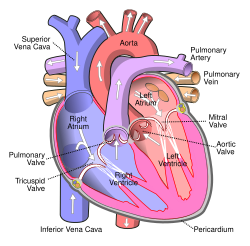Atrium (heart)
chamber of the heart
The atrium (Latin: ātrium, lit. 'entry hall') or auricle is the upper part through which blood enters the ventricles of the heart.
| Atrium | |
|---|---|
 Front view of heart showing the atria | |
| Details | |
| Part of | Heart vena cavae |
| System | Circulatory system |
| Identifiers | |
| Latin | Atrium |
| MeSH | D006325 |
| TA | A12.1.00.017 |
| FMA | 7099 85574, 7099 |
| Anatomical terminology | |
There are two atria in the human heart. The left atrium receives blood from the pulmonary (lung) circulation. The right atrium receives blood from the venae cavae (venous circulation).[1]
References
change- ↑ Parekh A, Jaladi R, Sharma S, Van Decker WA, Ezekowitz MD (September 2006). "Images in cardiovascular medicine. The case of a disappearing left atrial appendage thrombus: direct visualization of left atrial thrombus migration, captured by echocardiography, in a patient with atrial fibrillation, resulting in a stroke". Circulation. 114 (13): e513–14. doi:10.1161/CIRCULATIONAHA.106.617886. PMID 17000914.